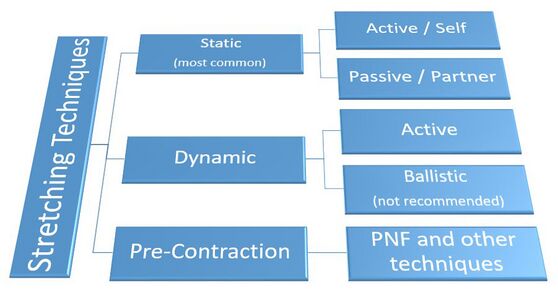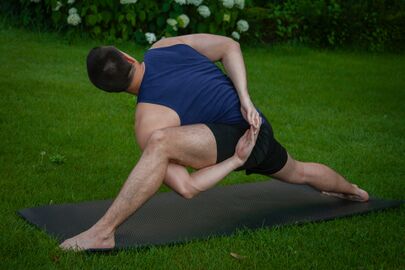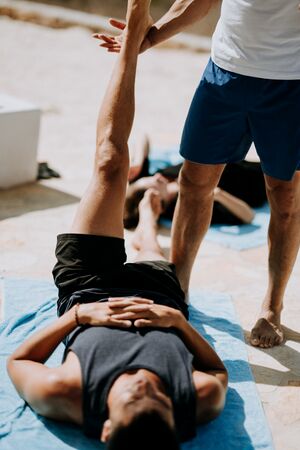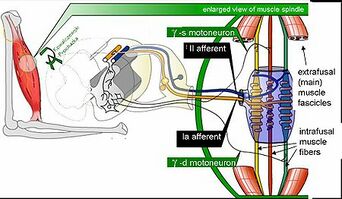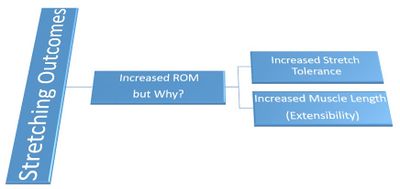Stretching
Purpose[edit | edit source]
Stretching exercises have traditionally been included as part of a training and recovery program. Evidence shows that physical performance in terms of maximal strength, number of repetitions and total volume are all affected differently by the each form of stretching:
- Static stretch (SS),
- Dynamic stretch (DS)
- Pre-contraction stretching (Proprioceptive Neuromuscular Facilitation stretching (PNFS), the most common type of this type.[1][2]
Stretching can help improve flexibility and range of motion about your joints. Improved flexibility may: Improve your performance in physical activities; Decrease your risk of injuries; Help your joints move through their full range of motion; Enable your muscles to work most effectively[3]
This 4 minute video is a good summary of stretching.
The below video gives a brief description of the types of stretching ( isometric stretching here is similar to PNFS)
Technique[edit | edit source]
Techniques of stretching include
1. Static Stretching
Static stretching (SS) is a type of stretching exercises in which elongation of muscle with application of low force and long duration (usually 30 sec).Static stretching has a relaxation, elongation effect on muscle, improving range of motion (ROM),decreasing musculotendinous stiffness and also reduces the risk of acute muscle strain injuries.[5] It is a slow controlled movement with emphasis on postural awareness and body alignment.It is suitable for all patient types.[6]
2. Dynamic Stretching
Dynamic Stretching (DS) involves the performance of a controlled movement through the available ROM. Involves progressively increasing the ROM through successive movements till the end of the range is reached in a repetitive and progressive manner. Dynamic Stretching:
- Can be functional and mimic the movement of the activity or sport to be performed performed. eg a swimmer may circle their arms before getting into the water.
- Helps restore dynamic function and neuromuscular control through repeating and practicing movement thus enhancing motor control.
- Sometimes considered preferable to SS in the preparation for physical activity.[7]See Impact of Static Stretching on Performance
- Elevates core temperature increasing: nerve conduction velocity; muscle compliance and enzymatic cycling; and accelerating energy production.[1]
Though somewhat similar, dynamic stretching is different from Ballistic stretching. Dynamic stretching involves moving parts of your body and gradually increasing the range of motion and or speed of movement. In comparison, ballistic stretches involve trying to force a part of the body beyond its range of motion. In dynamic stretches, there are no bounces or 'jerky' movements. [8] Because of increased risk for injury, ballistic stretching is no longer recommended.[2]
3. Pre-Contraction Stretching: Proprioceptive Neuromuscular Facilitation Stretching (PNFS)
This form of stretching involves a contraction of the muscle being stretched or its antagonist before stretching. PNF is the most common type, see below. Other types of pre-contraction stretching include “post-isometric relaxation” (PIR). This type of technique uses a much smaller amount of muscle contraction (25%) followed by a stretch. Post-facilitation stretch (PFS) is a technique developed by Dr Vladimir Janda that involves a maximal contraction of the muscle at mid-range with a rapid movement to maximal length followed by a 15-second static stretch.
Multiple PNF stretching techniques exist, all of them rely on stretching a muscle to its limit.This triggers the inverse stretch reflex, a protective reflex that calms the muscle to prevent injury. Regardless of technique, PNF stretching can be used on most muscles in the body.PNFS can also be modified so you can do them alone or with a partner.[9]
The types of PNF stretch techniques are: Contract Relax (CR) Contraction of the muscle through its spiral-diagonal PNF pattern,followed by stretch; Hold Relax (HR) Contraction of the muscle through the rotational component of the PNF pattern, followed by stretch; Contract-Relax Agonist Contract (CRAC) Contraction of the muscle through its spiral-diagonal PNF pattern, followed by contraction of opposite muscle to stretch target muscle.
Mechanisms of Stretching[edit | edit source]
The stretching of a muscle fiber begins with the sarcomere, the basic unit of contraction in the muscle fiber. As the sarcomere contracts, the area of overlap between the thick and thin myofilaments increases. As it stretches, this area of overlap decreases, allowing the muscle fiber to elongate. Once the muscle fiber is at its maximum resting length (all the sarcomeres are fully stretched), additional stretching places force on the surrounding connective tissue. As the tension increases, the collagen fibers in the connective tissue align themselves along the same line of force as the tension. Therefor when you stretch, the muscle fiber is pulled out to its full length sarcomere by sarcomere, and then the connective tissue takes up the remaining slack. When this occurs, it helps to realign any disorganized fibers in the direction of the tension. This realignment is what helps in the rehabilitation of scarred tissue.[10]
The initial changes that are produced by stretch training involve mechanical adaptations that are followed by neural adaptations, which contrasts with the sequence observed during strength training.[11]
When a muscle is stretched, some of its fibers lengthen, but other fibers may remain at rest. The more fibers that are stretched, the greater the length developed by the stretched muscle.
Proprioceptors: The proprioceptors related to stretching are located in the tendons and in the muscle fibers.
- Muscle spindles (intrafusal fibers) lie parallel to the extrafusal fibers. Muscle spindles are the primary proprioceptors in the muscle.
- Another proprioceptor that comes into play during stretching is located in the tendon near the end of the muscle fiber and is called the golgi tendon organ.
- A third type of proprioceptor, called a pacinian corpuscle, is located close to the golgi tendon organ and is responsible for detecting changes in movement and pressure within the body[10].
The Stretch Reflex[edit | edit source]
When the muscle is stretched, so is the muscle spindle. The muscle spindle records the change in length (and how fast) and sends signals to the spine which convey this information. This triggers the stretch reflex which attempts to resist the change in muscle length by causing the stretched muscle to contract. The more sudden the change in muscle length, the stronger the muscle contractions will be (plyometric training is based on this fact). This basic function of the muscle spindle helps to maintain muscle tone and to protect the body from injury. One of the reasons for holding a stretch for a prolonged period of time is that as you hold the muscle in a stretched position, the muscle spindle habituates and reduces its signalling. Gradually, you can train your stretch receptors to allow greater lengthening of the muscles[10].
The below 5 minute video gives is on the stretch mechanism
Indications[edit | edit source]
Indications for stretching include:
- Improve joint ROM
- Increase extensibility of muscle tendon unit and periarticular connective tissue
- Return normal neuromuscular balance between muscle groups
- Reduce compression on joint surfaces
- Reduce injuries
- May be used prior to and after vigorous exercise to potentially reduce post-exercise muscle soreness[12]
Contraindications[edit | edit source]
Include:
- Joint motion limited by bony blocks
- After fracture and before bone healing is complete
- Acute inflammatory or infectious process
- When disruption of soft tissue healing is likely
- Sharp, acute pain with joint movement or muscle elongation
- Hematoma or other soft tissue trauma
- Hypermobility exists[12]
Evidence[edit | edit source]
A 2012 study on the evidence surrounding stretching techniques found that the benefits of stretching seem to be individual to the population studied.To increase ROM, all types of stretching are effective, although PNF-type stretching may be more effective for immediate gains.To avoid decrease in strength and performance that may occur in athletes due to static stretching before competition or activity, dynamic stretching is recommended for warm-up.Older adults over 65 years old should incorporate static stretching into an exercise regimen.A variety of orthopedic patients can benefit from both static and pre-contraction stretching.[2]
Outcome[edit | edit source]
Increased ROM as a result of stretching exercises can be a result of patients/athletes ability to withstand more stretching force or a real increase in muscle length [2]."İncreased stretch tolerance" term is used for ability to withstand more stretching force.Increased muscle length or increased extensibility terms are used for real increase in muscle length.Measurement of passive ROM is not sufficient to measure extensibility. Passive ROM should be measured with reference loads to identify increased stretch tolerance and increased extensibility.
Final Words[edit | edit source]
- To increase joint range of motion all types of stretching are effective, PNF-type stretching may be more effective for immediate gains.
- Dynamic stretching is recommended for warm-up for athletes before competition or activity.As static stretching will likely decrease strength and may influence performance.[13]
- Post exercise static stretching or Proprioceptive Neuromuscular Facilitation stretching is recommended for reducing muscle injuries and increasing joint range of motion.[14] Although Stretching has not been shown to be effective at reducing the incidence of overall injuries.
- Stretching is often included in Physiotherapy interventions for management of many kinds of clinical injuries. Despite positive outcomes, it is difficult to isolate the effectiveness of the stretching component of the total treatment plan because the protocols usually include strengthening and other interventions in addition to stretching.[1]
References[edit | edit source]
- ↑ 1.0 1.1 1.2 POGO An evidence based guide to stretching Available from: https://www.pogophysio.com.au/blog/performance-maximisation/ (last accessed 1.6.2019)
- ↑ 2.0 2.1 2.2 2.3 Page P. Current concepts in muscle stretching for exercise and rehabilitation. International journal of sports physical therapy. 2012 Feb;7(1):109. Available from: https://www.ncbi.nlm.nih.gov/pmc/articles/PMC3273886/ (last accessed 1.6.2019)
- ↑ Mayo Clinic Stretching Available from: https://www.mayoclinic.org/healthy-lifestyle/fitness/in-depth/stretching/art-20047931 (last accessed 1.6.2019)
- ↑ Rachael Goepper Types of stretching Available from: https://www.youtube.com/watch?v=3V_L7ArBn_A (last accessed 1.6.2019)
- ↑ Physiopedia Impact of static stretching on muscle performance Available from: https://www.physio-pedia.com/Impact_of_Static_Stretching_on_Performance (last accessed 1.6.2019)
- ↑ Kay AD, Blazevich AJ. Effect of acute static stretch on maximal muscle performance: a systematic review. Medicine & Science in Sports & Exercise®. 2012 Jan 1;44(1):154-64. Available from: https://insights.ovid.com/medicine-science-sports-exercise/mespex/2012/01/000/effect-acute-static-stretch-maximal-muscle/20/00005768 (last accessed 3.6.2019)
- ↑ Mason D Exercise in rehabilitation In: Porter S Tidy's Physiotherapy Sydney Elsevier 2013 pages 281-284
- ↑ Top end sports Dynamic stretching Available:https://www.topendsports.com/medicine/stretching-dynamic.htm (accessed 26.12.2021)
- ↑ Healthline PNF stretching Available from: https://www.healthline.com/health/fitness-exercise/pnf-stretching#pnf-techniques (last accessed 1.6.2019)
- ↑ 10.0 10.1 10.2 Appleton B. Stretching and Flexibility Everything you never wanted to know. World. 1998:68. Available: https://3yryua3n3eu3i4gih2iopzph-wpengine.netdna-ssl.com/wp-content/uploads/2016/07/pdf/stretching.pdf(accessed 26.12.2021)
- ↑ Guissard N, Duchateau J. Neural aspects of muscle stretching. Exercise and sport sciences reviews. 2006 Oct 1;34(4):154-8. Available:https://journals.lww.com/acsm-essr/Fulltext/2006/10000/Neural_Aspects_of_Muscle_Stretching.3.aspx (accessed 26.12.2021)
- ↑ 12.0 12.1 Quizlet Purposes, Indications and Contradications of Stretching Exercises Available :https://quizlet.com/121027822/purposes-indications-and-contradications-of-stretching-exercises-flash-cards/ (accessed 26.12.2021)
- ↑ Shrier I. Does stretching improve performance?: a systematic and critical review of the literature. Clinical Journal of sport medicine. 2004 Sep 1;14(5):267-73. Available from: https://insights.ovid.com/clinical-sport-medicine/cjspm/2004/09/000/does-stretching-improve-performance-systematic/4/00042752 (last accessed 3.6.2019)
- ↑ Sharman MJ, Cresswell AG, Riek S. Proprioceptive neuromuscular facilitation stretching. Sports medicine. 2006 Nov 1;36(11):929-39. Available from: https://www.ncbi.nlm.nih.gov/pubmed/17052131 (last accessed 3.6.2019)
